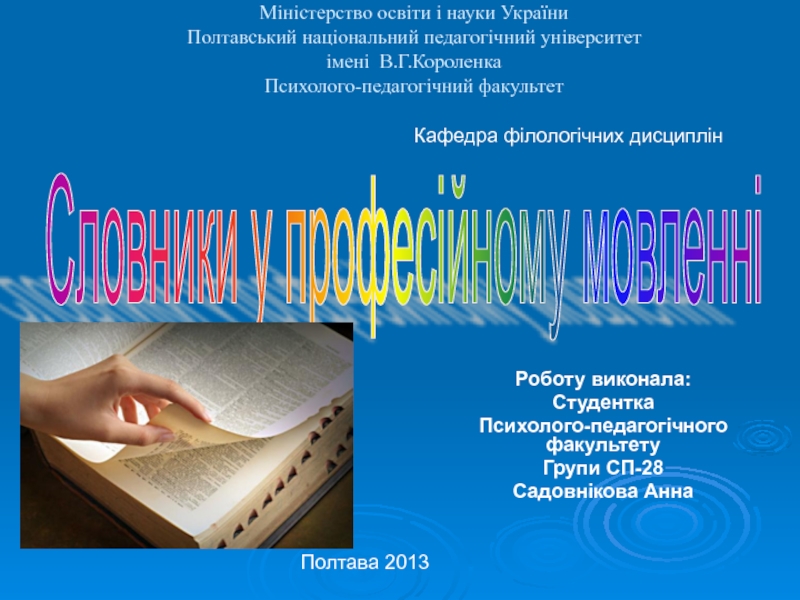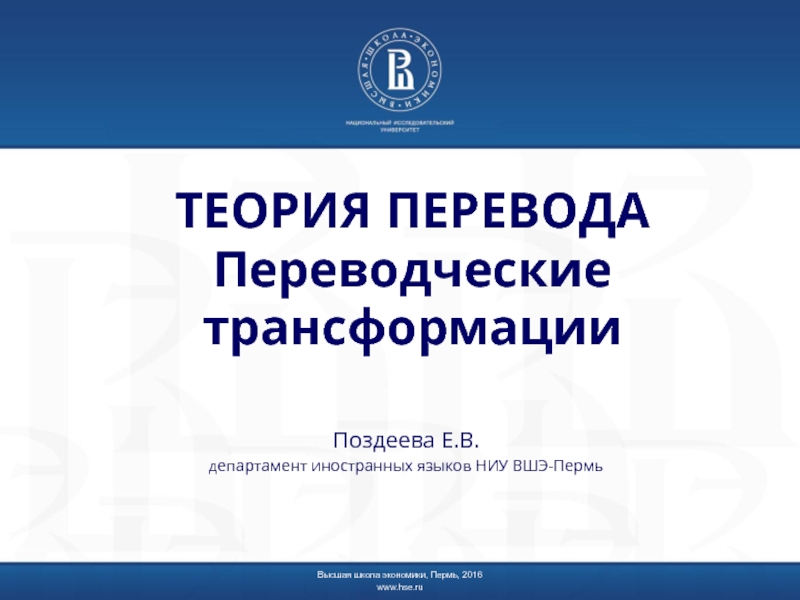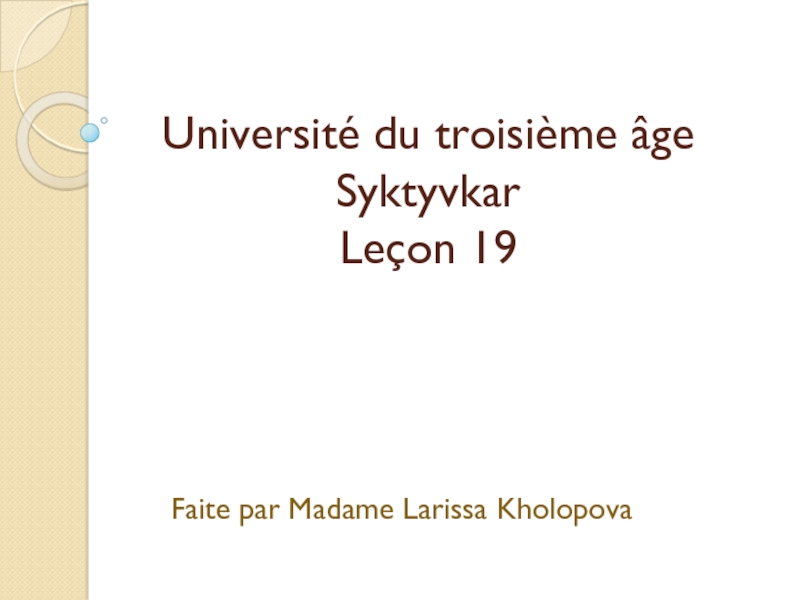- Главная
- Разное
- Дизайн
- Бизнес и предпринимательство
- Аналитика
- Образование
- Развлечения
- Красота и здоровье
- Финансы
- Государство
- Путешествия
- Спорт
- Недвижимость
- Армия
- Графика
- Культурология
- Еда и кулинария
- Лингвистика
- Английский язык
- Астрономия
- Алгебра
- Биология
- География
- Детские презентации
- Информатика
- История
- Литература
- Маркетинг
- Математика
- Медицина
- Менеджмент
- Музыка
- МХК
- Немецкий язык
- ОБЖ
- Обществознание
- Окружающий мир
- Педагогика
- Русский язык
- Технология
- Физика
- Философия
- Химия
- Шаблоны, картинки для презентаций
- Экология
- Экономика
- Юриспруденция
The phoneme theory презентация
Содержание
- 1. The phoneme theory
- 2. Outline 1. The phoneme and its definition
- 3. The Phoneme and Its Definition phoneme
- 4. The Phoneme and Its Definition “The phoneme
- 5. Aspects of the Phoneme The aspects: material abstract
- 6. forelingual apical alveolar plosive (stop) fortis (voiceless) aspirated occlusive The Sound [t] in Isolation
- 7. The Allophones of the Phoneme [t] 1.
- 8. The Allophones of the Phoneme [t] no
- 9. The Invariant of the Phoneme [t] The bundle of distinctive articulatory features: occlusive forelingual fortis
- 10. The Invariant of the Phoneme [t] forelingual
- 11. The phonemes differentiate the meaning of: 1)
- 12. Irrelevant Features of Phonemes
- 13. 3. Types of Mistakes I. Phonological: e.g.
- 14. Types of Mistakes II. Phonetic: e.g.
- 15. 4. The Phoneme Theory at Home and
- 16. The Phoneme Theory at Home and Abroad
- 17. The Phoneme Theory at Home and Abroad
- 18. 5. Methods of Phonological Investigation 1. semantically
- 19. Methods of Phonological Investigation a system
- 20. Methods of Phonological Investigation [h] is
- 21. 6. Morphonology To establish
- 22. Morphonology the Moscow School (morphological) The phonemic
- 23. Morphonology The variation of the allophones of
- 24. the Leningrad School (Scherba’s school) Л.Р.
- 25. [bdkt - bdekt] []
- 26. Thank you
Слайд 2Outline
1. The phoneme and its definition
2. Aspects of the phoneme
3. Types
of mistakes
4. The Phoneme Theory at home and abroad
5. Methods of Phonological Investigation
6. Morphonology
4. The Phoneme Theory at home and abroad
5. Methods of Phonological Investigation
6. Morphonology
Слайд 3The Phoneme and Its Definition
phoneme [fni:m]
N.V. Krushevsky (1851-1887)
Baudouin de Courtenay
(1845-1929)
[b dwæn d k: tn ]
noticeable
[b dwæn d k: tn ]
noticeable
Слайд 4The Phoneme and Its Definition
“The phoneme is the smallest, further indivisible
language unit that exists in the speech of all members of a given language community as such speech sounds which are capable of differentiating one word from another or one grammatical form of a word from another grammatical form of the same word.”
(prof. Vassilyev 1970)
(prof. Vassilyev 1970)
Слайд 5Aspects of the Phoneme
The aspects: material
abstract
functional
allophone [ælfn]
principal [prntspl]
secondary (subsidiary)
relevant (distinctive)
irrelevant (nondistinctive)
Слайд 6 forelingual
apical
alveolar
plosive (stop)
fortis (voiceless)
aspirated
occlusive
The Sound [t] in Isolation
Слайд 7The Allophones of the Phoneme [t]
1. principal: [t:]
2. subsidiary:
[ti:] (palatalized)
[let
ðm] dental (not alveolar)
[nt ðm]
[nt ðm]
[tra]
[tri:] post alveolar
[tre]
Слайд 8The Allophones of the Phoneme [t]
no plosion: [nt kwat]
[nt kl]
lateral
plosion: [nt ltl]
[nt let]
not aspirated: [ste]
[st:]
labialized: [twas]
[nt let]
not aspirated: [ste]
[st:]
labialized: [twas]
Слайд 9The Invariant of the Phoneme [t]
The bundle of distinctive articulatory features:
occlusive
forelingual
fortis
Слайд 10The Invariant of the Phoneme [t]
forelingual – backlingual articulation
[t:n - k:n]
[tra - kra]
fortis-lenis
[t:n - d:n] [ta - da]
occlusive – constrictive articulation
[ti: -si:] [tld - sld]
fortis-lenis
[t:n - d:n] [ta - da]
occlusive – constrictive articulation
[ti: -si:] [tld - sld]
Слайд 11The phonemes differentiate the meaning of:
1) morphemes:
[sli:p - sli:p]
[sefl - seft]
2)
words:
[pe - be]
[t:n - d:n]
3) sentences:
I don’t like this cat. – I don’t like this cut.
I don’t like this girl. – I don’t like this curl.
[pe - be]
[t:n - d:n]
3) sentences:
I don’t like this cat. – I don’t like this cut.
I don’t like this girl. – I don’t like this curl.
Слайд 12Irrelevant Features of Phonemes
vowel length
aspiration
A Phonological Opposition (Distinctive)
e.g.
[h:d - h:t] (lenis-fortis articulation
Слайд 133. Types of Mistakes
I. Phonological:
e.g. [ri: - tri:]
1) The place of
articulation:
[] - interdental
[t] - alveolar
2) The manner of noise production:
[] - fricative, constrictive
[t] – occlusive, stop
[] - interdental
[t] - alveolar
2) The manner of noise production:
[] - fricative, constrictive
[t] – occlusive, stop
Слайд 14Types of Mistakes
II. Phonetic:
e.g. [let ðm]
alveolar or dental [t]
[i:i:p]
overlengthened [i:]
Слайд 154. The Phoneme Theory at Home and Abroad
to exaggerate
to ignore
I.A. Baudouin
de Courtenay
[bdwæn d k:tni]
a fictitious unit [fkts]
a psychical image [sakkl]
idealistic [adlstk]
[bdwæn d k:tni]
a fictitious unit [fkts]
a psychical image [sakkl]
idealistic [adlstk]
Слайд 16The Phoneme Theory at Home and Abroad
L.V. Scherba (1880-1944)
“Russian Vowels in
Qualitative and Quantitative Aspects” (1911)
“A Manual of French Phonetics”
The Prague School of Linguistics
Vilem Mathesius (1882-1945)
Богумил Трнка
Богуслав Гавранек
Йозеф Вахек
Р.О. Якобсон (Roman Jacobson)
Н.С. Трубецкой (1990-1938)
“A Manual of French Phonetics”
The Prague School of Linguistics
Vilem Mathesius (1882-1945)
Богумил Трнка
Богуслав Гавранек
Йозеф Вахек
Р.О. Якобсон (Roman Jacobson)
Н.С. Трубецкой (1990-1938)
Слайд 17The Phoneme Theory at Home and Abroad
Ferdinand de Saussure (1857-1913)
[
f:dnænd d ssj]
Twaddel [twdel]
Leonard Bloomfield [lend blu:mfi:ld]
Daniel Jones [dænjl dnz]
vulgarly – materialistic
Bloch [blh]
Trager [treg]
Twaddel [twdel]
Leonard Bloomfield [lend blu:mfi:ld]
Daniel Jones [dænjl dnz]
vulgarly – materialistic
Bloch [blh]
Trager [treg]
Слайд 185. Methods of Phonological Investigation
1. semantically – distributional:
Phonemes can distinguish meaning
when opposed to one another.
Allophones of the same phoneme never occur in the same phonetic context.
a commutation test:
a). [pn – sn]
b). [pn - pn]
c). [pn – hn]
Allophones of the same phoneme never occur in the same phonetic context.
a commutation test:
a). [pn – sn]
b). [pn - pn]
c). [pn – hn]
Слайд 19 Methods of Phonological Investigation
a system of oppositions:
- single: [pen –
ben] fortis-lenis
double: [pen – den]
bilabial – forlingual fortis-lenis
triple: [pen – ðen]
bilabial – forlingual occlusive - constrictive
fortis-lenis
double: [pen – den]
bilabial – forlingual fortis-lenis
triple: [pen – ðen]
bilabial – forlingual occlusive - constrictive
fortis-lenis
Слайд 20 Methods of Phonological Investigation
[h] is never used at the end
[ŋ]
is never used at the beginning
2. substitutional (formally distributional)
шкаф – шкап
The sounds are different but the meaning is the same.
2. substitutional (formally distributional)
шкаф – шкап
The sounds are different but the meaning is the same.
Слайд 216. Morphonology
To establish the phonemic status of sounds when
their distinctive features are neutralized.
[bdkt -bdekt] [] – []
лук – луг (луга) [k]
the Moscow School (morphological)
П.С. Кузнецов
А.А. Реформатский
Р.И. Аванесов
[bdkt -bdekt] [] – []
лук – луг (луга) [k]
the Moscow School (morphological)
П.С. Кузнецов
А.А. Реформатский
Р.И. Аванесов
Слайд 22Morphonology
the Moscow School (morphological)
The phonemic status of the morpheme is constant,
it cannot vary.
A strong position of a vowel is when it is stressed.
A strong position of a consonant is before a vowel.
A strong position of a vowel is when it is stressed.
A strong position of a consonant is before a vowel.
Слайд 23Morphonology
The variation of the allophones of the same phoneme is not
limited. One and the same sound can belong to different phonemes.
[bdkt -bdekt] - the morphemes are the same, so the sounds [] and [] are the allophones of the same phoneme.
лук – луг (луга)– the morphemes are different, so the allophones [k] belong to different phonemes.
[bdkt -bdekt] - the morphemes are the same, so the sounds [] and [] are the allophones of the same phoneme.
лук – луг (луга)– the morphemes are different, so the allophones [k] belong to different phonemes.
Слайд 24
the Leningrad School (Scherba’s school)
Л.Р. Зиндер
М.И. Матусевич
Л.В. Бондарко
В.А. Васильев
One and
the same sound cannot belong to different phonemes.
The difference between the allophones of the same phoneme is limited.
The difference between the allophones of the same phoneme is limited.
Слайд 25
[bdkt - bdekt] [] and [] – allophones of
different phonemes.
лук – луг (луга) – the allophones [k] belong to the same phoneme.
[dg - led]
корзина, корова, собака, [dekret]
[nju:z – nju:spep]
лук – луг (луга) – the allophones [k] belong to the same phoneme.
[dg - led]
корзина, корова, собака, [dekret]
[nju:z – nju:spep]
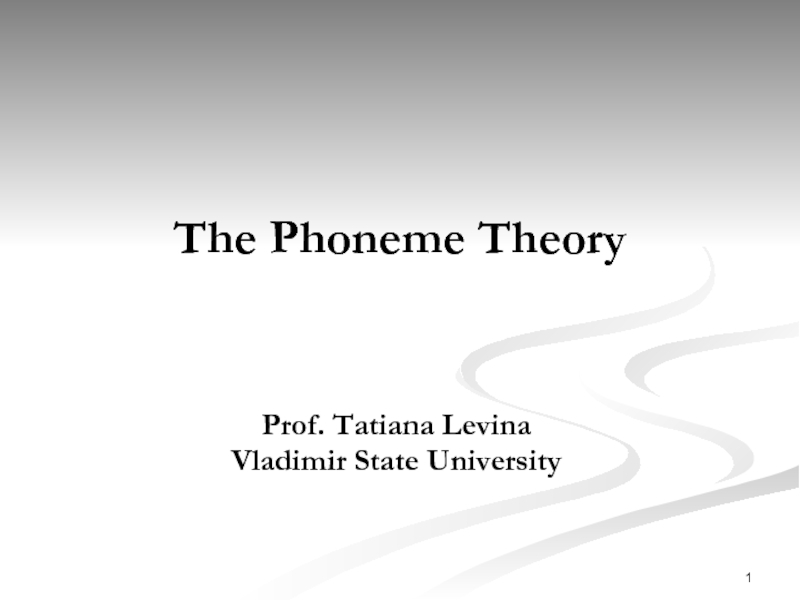
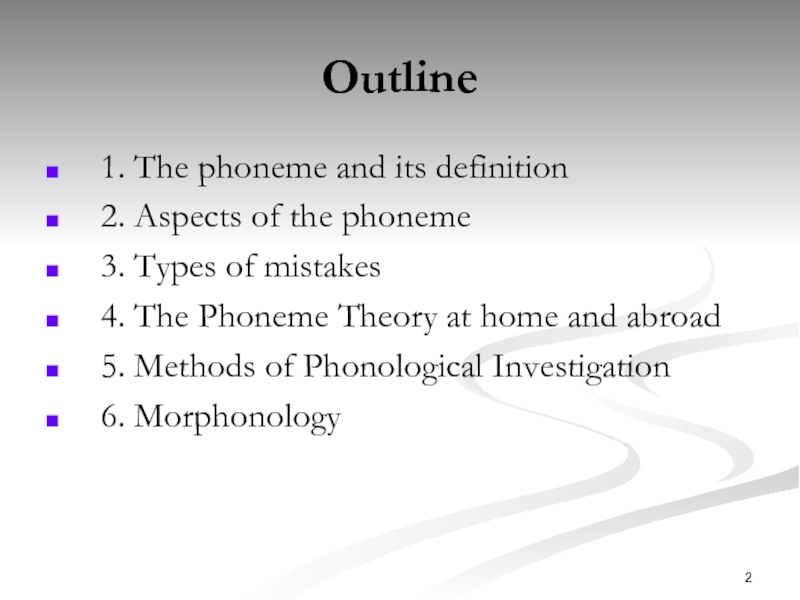
![The Phoneme and Its Definition phoneme [fni:m] N.V. Krushevsky (1851-1887) Baudouin de Courtenay (1845-1929) [b dwæn d k:](/img/tmb/5/498781/610104c6ce718b8843116443cdee8502-800x.jpg)
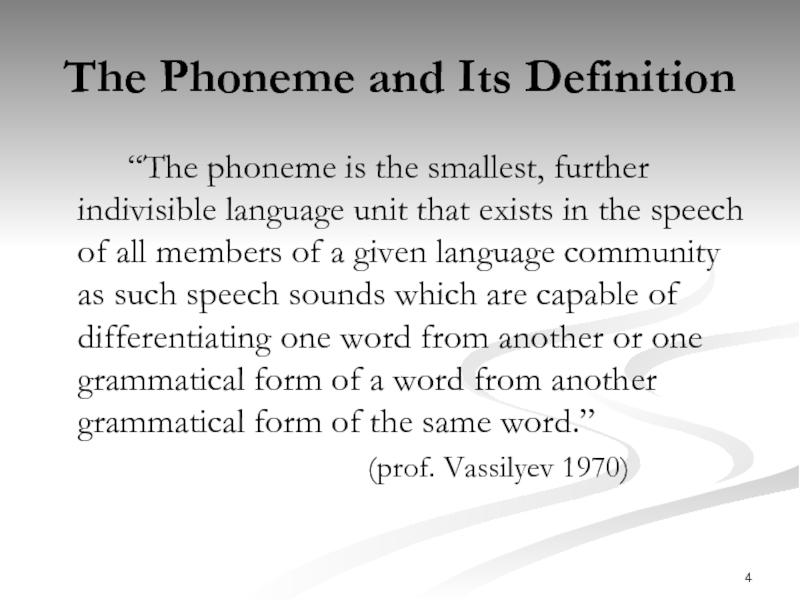
![Aspects of the PhonemeThe aspects: material abstract functionalallophone [ælfn] principal [prntspl] secondary (subsidiary) relevant (distinctive) irrelevant (nondistinctive)](/img/tmb/5/498781/7e67839878863231377e2046ca2ff0a6-800x.jpg)
![forelingual apical alveolar plosive (stop) fortis (voiceless) aspirated occlusiveThe Sound [t] in Isolation](/img/tmb/5/498781/6f074275ae0b098265d716f249d4170c-800x.jpg)
![The Allophones of the Phoneme [t]1. principal: [t:]2. subsidiary: [ti:] (palatalized)[let ðm] dental (not alveolar)[nt ðm] [tra][tri:] post alveolar[tre]](/img/tmb/5/498781/7087857e52e30b50494c4c3cf4f9ffdb-800x.jpg)
![The Allophones of the Phoneme [t] no plosion: [nt kwat] [nt kl] lateral plosion: [nt ltl] [nt](/img/tmb/5/498781/8514d79881887c044f7614b77f73bdc3-800x.jpg)
![The Invariant of the Phoneme [t] The bundle of distinctive articulatory features:occlusiveforelingualfortis](/img/tmb/5/498781/ffd756965d7d9dea4548c983669c3a68-800x.jpg)
![The Invariant of the Phoneme [t]forelingual – backlingual articulation [t:n - k:n] [tra - kra]fortis-lenis [t:n -](/img/tmb/5/498781/0b6d19cc62ff05052b341524f4ab1682-800x.jpg)
![The phonemes differentiate the meaning of:1) morphemes: [sli:p - sli:p] [sefl - seft]2) words: [pe - be] [t:n -](/img/tmb/5/498781/edfbd1c2448ff70d09ff63ec265b1e87-800x.jpg)
![Irrelevant Features of Phonemes vowel length aspirationA Phonological Opposition (Distinctive)e.g. [h:d - h:t] (lenis-fortis](/img/tmb/5/498781/ca6fde75a860fa485a46fbcf2d199cfc-800x.jpg)
![3. Types of Mistakes I. Phonological: e.g. [ri: - tri:]1) The place of articulation: [] - interdental [t] -](/img/tmb/5/498781/10a64a97f04a9adfbe144ce6fc4133b7-800x.jpg)
![Types of Mistakes II. Phonetic: e.g. [let ðm] alveolar or dental [t] [i:i:p] overlengthened [i:]](/img/tmb/5/498781/ff050fe1af43720ae6c78fb11ca7a5f5-800x.jpg)
![4. The Phoneme Theory at Home and Abroad to exaggerate to ignoreI.A. Baudouin de Courtenay [bdwæn d k:tni] a](/img/tmb/5/498781/ce37187723d91c0ac7a27ca86c4f281b-800x.jpg)
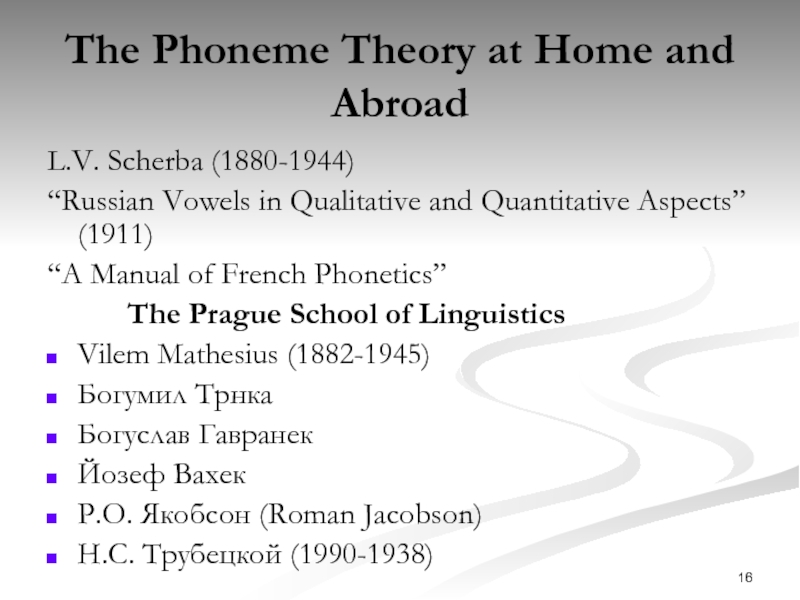
![The Phoneme Theory at Home and AbroadFerdinand de Saussure (1857-1913) [ f:dnænd d ssj] Twaddel [twdel]Leonard](/img/tmb/5/498781/8b4326bb90e31108a4f7b2a2ac7520a3-800x.jpg)
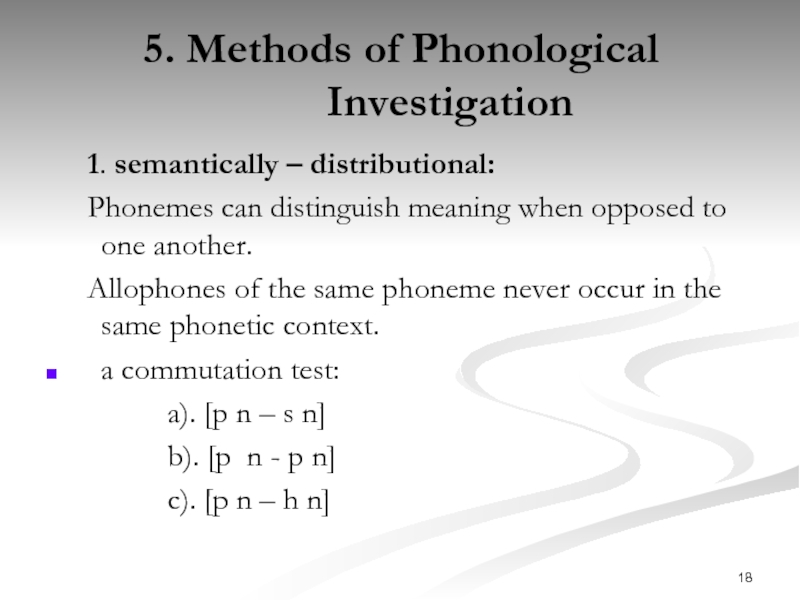
![Methods of Phonological Investigationa system of oppositions:- single: [pen – ben] fortis-lenisdouble: [pen –](/img/tmb/5/498781/03468858f72946750b76005dd4cfdfb0-800x.jpg)
![Methods of Phonological Investigation [h] is never used at the end [ŋ] is never used at](/img/tmb/5/498781/175b262b1c30bad0ac89d01543c1ba0f-800x.jpg)
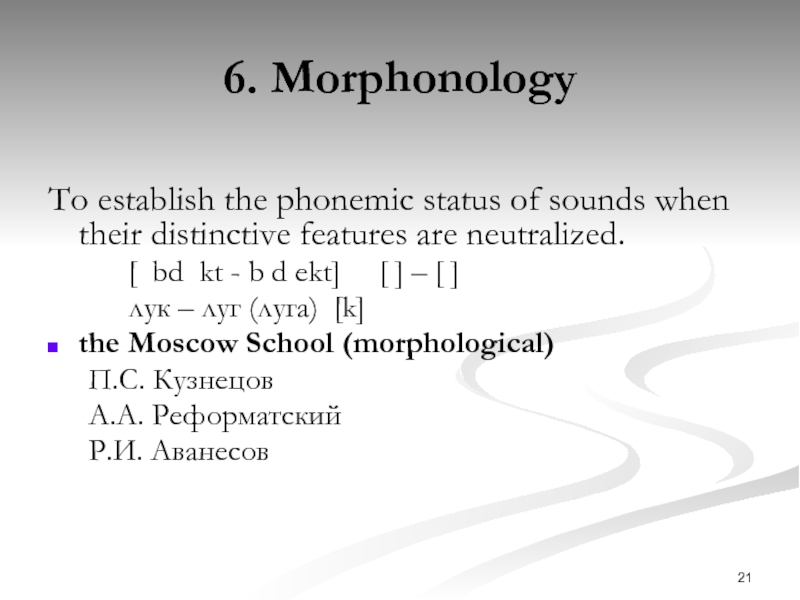
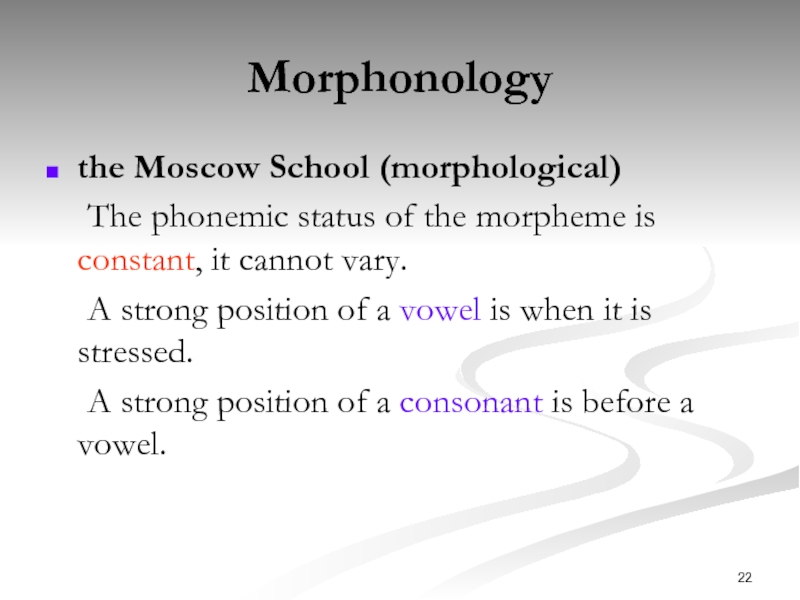
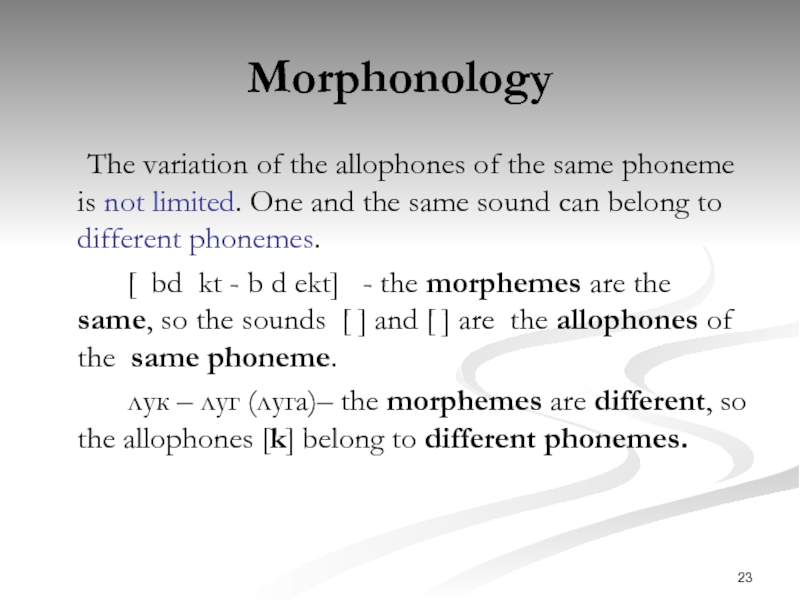
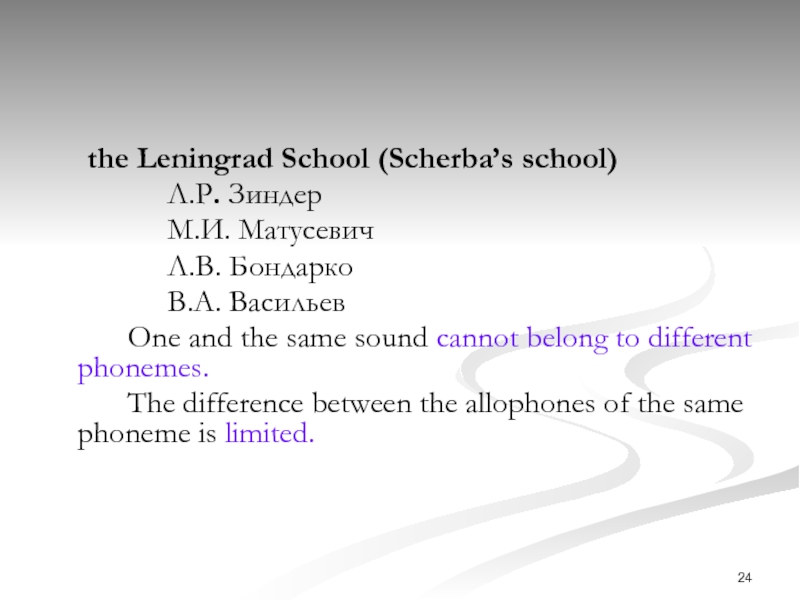
![[bdkt - bdekt] [] and [] – allophones of different phonemes.лук – луг (луга)](/img/tmb/5/498781/8de1d3fce77a7b8cf772f6346b9ca5d9-800x.jpg)



